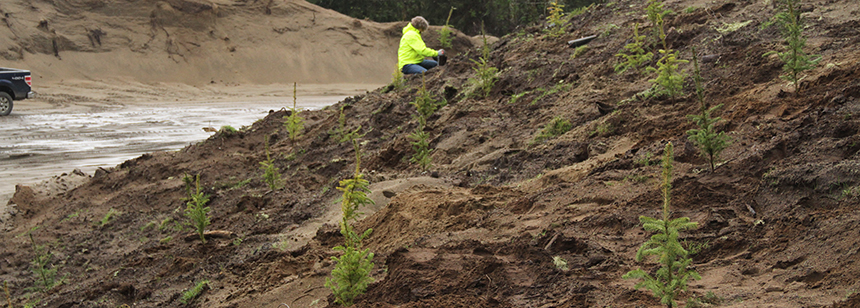
Clear Lake
In 2013 North Coast Land Conservancy acquired the last un-conserved lake on the Warrenton peninsula and set about creating new wetland habitat in what had been a degraded upland area adjacent to the lake. Now, three years later, that project is nearing completion—at least the human intervention part. With native plants and animals already moving into the area, it can be considered a success—or as Stewardship Director Melissa Reich puts it, “Now the good stuff wants to move in.”

Excavation of wetlands at Clear Lake, February 2014
Clear Lake lies at the center of a large and thriving wetlands system tucked between downtown Warrenton and Fort Stevens State Park. The lake itself is pristine, but the 47 acres NCLC acquired included a dune area that had been heavily grazed and disturbed. NCLC immediately began excavating the disturbed sand dune with heavy equipment and removing ditches that had been used to drain wetlands, creating new wetlands at the same elevation as the surrounding wetlands. It was as if the land itself had been waiting for this boost; “Even during excavation,” Reich recalls, “a bald eagle flew in and took a bath in the newly created wetlands.” Within months, staff and volunteers did a first planting of native species. As the excavation wrapped, volunteers have returned to the site, most recently on March 23, to plant more willows and bare-root shrubs.

First planting at Clear Lake, March 2014
Native Pacific tree frogs have already given the new wetlands a thumbs-up; the ponds here are now teeming with tadpoles. Beavers are busy in the wetlands adjacent to the restoration site. Alder and willow seedlings are appearing on their own, as are native aquatic plants. “There are very few invasive plants on the property,” Reich notes, “so I expect that here we could do nothing in the way of planting and we would still have really healthy wetlands full of native plants. That is not usually the case.”

Plantings were becoming well established by July 2015
Clear Lake lies in the heart of the area targeted by North Coast Land Conservancy’s Columbia Quiet Waters Conservation Initiative, close to its Gardenia Wetland and Ridge Road Swamp habitat reserves. That connectivity boosts the conservancy’s efforts to maintain and promote wildlife corridors and other kinds of ecological connectivity at the mouth of the Columbia River.

Beaver have been busy in existing wetlands adjacent to Clear Lake and the reborn wetlands nearby.
“The benefits of this small restoration project are really big, because it’s surrounded by this big, intact wetland system,” said NCLC Executive Director Katie Voelke. “Our acquisition of this land and the cooperation of landowner Rod Gramson is what made it possible.”

Planting at edge of recently excavated wetland, March 2016
Comments